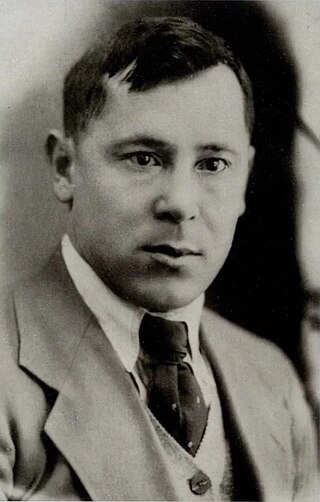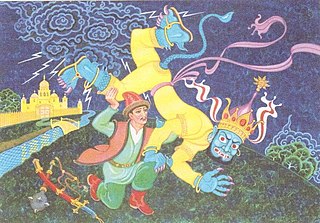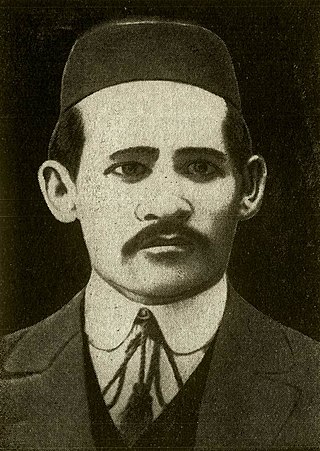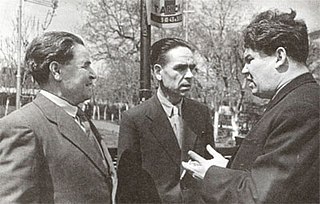
The Bashkirs or Bashkorts are a Turkic ethnic group indigenous to Russia. They are concentrated in Bashkortostan, a republic of the Russian Federation and in the broader historical region of Badzhgard, which spans both sides of the Ural Mountains, where Eastern Europe meets North Asia. Smaller communities of Bashkirs also live in the Republic of Tatarstan, the oblasts of Perm Krai, Chelyabinsk, Orenburg, Tyumen, Sverdlovsk and Kurgan and other regions in Russia; sizeable minorities exist in Kazakhstan and Uzbekistan.

Ğabdulla Möxəmmətğərif ulı Tuqay was a Volga Tatar poet, critic, publisher, and towering figure of Tatar literature. Tuqay is often referred to as the founder of modern Tatar literature and the modern Tatar literary language, which replaced Old Tatar.

Musa Cälil was a Soviet Tatar poet and resistance fighter during World War II. He is the only poet of the Soviet Union awarded simultaneously the Hero of the Soviet Union award for his resistance fighting and the Lenin Prize for having written The Moabit Notebooks; both awards were bestowed upon him posthumously.
Salawat Yulayev was a Bashkir national hero who helped lead the Pugachev's Rebellion. He was also a poet and singer.

Pugachev's Rebellion of 1773–1775 was the principal revolt in a series of popular rebellions that took place in the Russian Empire after Catherine II seized power in 1762. It began as an organized insurrection of Yaik Cossacks headed by Yemelyan Pugachev, a disaffected ex-lieutenant of the Imperial Russian Army, against a background of profound peasant unrest and war with the Ottoman Empire. After initial success, Pugachev assumed leadership of an alternative government in the name of the late Tsar Peter III and proclaimed an end to serfdom. This organized leadership presented a challenge to the imperial administration of Catherine II.

In Slavic folklore, the rusalka is a female entity, often malicious toward mankind and frequently associated with water. It has counterparts in other parts of Europe, such as the French Melusine and the Germanic Nixie. Folklorists have proposed a variety of origins for the entity, including that they may originally stem from Slavic paganism, where they may have been seen as benevolent spirits. Rusalki appear in a variety of media in modern popular culture, particularly in Slavic language-speaking countries, where they frequently resemble the concept of the mermaid.

Ural-batyr or Oral-batır is the most famous kubair of the Bashkirs. It is a telling of heroic deeds and legendary creatures, the formation of natural phenomena, and so on.

The Malachite Box or The Malachite Casket is a book of fairy tales and folk tales of the Ural region of Russia compiled by Pavel Bazhov and published from 1936 to 1945. It is written in contemporary language and blends elements of everyday life with fantastic characters. It was awarded the Stalin prize in 1942. Bazhov's stories are based on the oral lore of the miners and gold prospectors.

Majit Gafuri was a Bashkir and Tatar poet, writer, and playwright. He was one of the leaders of the democratic trend in Tatar literature and one of the founders of national children's literature.

Bichura is a house spirit in Turkic mythology.

In Turkic mythology, Su Iyesi is a water spirit. It corresponds to the nymph in Turkic cultures. It is a disembodied, incorporeal, intangible entity, but can turn into a male as well as a female creature who is the daughter of Yer Tanrı. Sometimes the master of water is depicted in the form of a bull.
In Turkic mythology, Abzar iyesi is a household spirit. It is the protector spirit of courtyard. Lives in the garden or courtyard of house.
In Turkic mythology Ergene iyesi is an underground spirit. It is the protector spirit of mine pit, and can turn into an animal. The word "İye" means owner, master or possessor. Also known as Shakhta iyesi.

Murat Abdulkhakovich Kamaletdinov was a Bashkir petroleum geologist.
"Silver Hoof" is a fairy tale short story written by Pavel Bazhov, based on the folklore of the Ural region of Siberia. It was first published in Uralsky Sovremennik in 1938, and later included in The Malachite Casket collection. In this fairy tale, the characters meet the legendary zoomorphic creature from the Ural folklore called Silver Hoof. In 1944 the story was translated from Russian into English by Alan Moray Williams and published by Hutchinson. In the 1950s another translation was made by Eve Manning. It was included in James Riordan's collection of stories The Mistress of the Copper Mountain: Tales from the Urals, published in 1974 by Frederick Muller Ltd. Riordan heard the tales from a headteacher when he was bedridden in Sverdlovsk. After returning to England he rewrote the tales from memory, checking them against Bazhov's book. He preferred not to call himself "translator", he believed that "communicator" was more appropriate.
"Beloved Name" or "That Dear Name" is a folk tale of the Ural region of Siberia collected and reworked by Pavel Bazhov. It was first published in the 11th issue of the Krasnaya Nov literary magazine in 1936 and later the same year as a part of the collection Prerevolutionary Folklore of the Urals. It was later released as a part of the collection of tales, The Malachite Casket. This skaz describes how the first Cossacks came to the Ural Mountains and were faced a tribe of the "Old People" who didn't know the value of gold. The Cossacks decide to take away the lands of the Old People. The tale features the female creature from the Ural folklore called the Azov Girl. The story was translated from Russian into English by Alan Moray Williams in 1944, and by Eve Manning in the 1950s.
"Golden Hair" is a Bashkir folk tale collected and reworked by Pavel Bazhov. It was first published in 1939 in the children's stories almanac Zolotye Zyorna released by Sverdlovsk Publishing House. It was later released as a part of The Malachite Casket collection. It was translated from Russian into English by Alan Moray Williams in 1944.

Babay or Babai is a night spirit (Bogeyman) in Slavic folklore. According to beliefs, he abducts children who do not sleep at night or behave badly. He is also called Babayka, Babayko or Bobo (Polish), although the term may also be applied to his female equivalent.

Äxmät İsxaq was a Soviet-Tatar poet, translator, and journalist.














